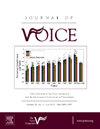CAPE-V 量表的临床使用:嗓音质量的一致性、可靠性和注意事项
IF 2.5
4区 医学
Q1 AUDIOLOGY & SPEECH-LANGUAGE PATHOLOGY
引用次数: 0
摘要
目的:CAPE-V 是一种广泛使用的协议,旨在帮助实现嗓音评估的标准化。嗓音质量评分的差异性阻碍了培训方案的开发,而培训方案本身可能会提高新临床医生之间的评分一致性。作为一个大型混合方法项目的一部分,本研究使用 CAPE-V 量表对有经验的临床医生的一致性和可靠性进行了检查:研究设计:观察法:方法:经验丰富的嗓音临床医生(20 人)对 12 位发言者的录音进行评分,这些发言者代表了不同的整体嗓音质量。研究人员会指导参与者使用 CAPE-V 量表对声音进行评分。我们记录了描述性数据,并计算了两级一致性。采用类内相关绝对一致的双向随机模型(ICC [2,1])计算单个评分者的可靠性:尽管大多数人对总体严重程度、呼吸感、粗糙度和应变进行了评分,但受试者对 CAPE-V 量表的使用存在很大差异。一名参与者的数据不符合先验一致性标准。由于没有他们的数据,结果会有很大不同,因此根据 19 名参与者的缩减数据集对一致性和可靠性进行了分析。研究人员之间的一致性和可靠性与之前的研究结果相当;在嗓音质量的所有维度上,评分的平均范围至少为 47 毫米:研究结果表明,在评估嗓音质量和发音障碍严重程度时,CAPE-V 表单和量表的组成部分有不同的使用方法,包括对 CAPE-V 所有主要嗓音质量维度的评分之间存在分类差异,这可能会使临床上将嗓音描述为轻度、中度或重度发音障碍复杂化。本文章由计算机程序翻译,如有差异,请以英文原文为准。
Clinical Use of the CAPE-V Scales: Agreement, Reliability and Notes on Voice Quality
Objectives
The CAPE-V is a widely used protocol developed to help standardize the evaluation of voice. Variability of voice quality ratings has prevented development of training protocols that might themselves improve interrater agreement among new clinicians. As part of a larger mixed methods project, this study examines agreement and reliability for experienced clinicians using the CAPE-V scales.
Study Design
Observational.
Methods
Experienced voice clinicians (N=20) provided ratings of recordings from 12 speakers representing a range of overall voice quality. Participants were instructed to rate the voices as they normally would, using the CAPE-V scales. Descriptive data were recorded and two levels of agreement were calculated. Single rater reliability was calculated using a 2-way random model of absolute agreement for intraclass correlations (ICC [2,1]).
Results
Participants use of the CAPE-V scales varied considerably, although most rated overall severity, breathiness, roughness and strain. Data from one participant did not meet a priori agreement criteria. Because outcomes were significantly different without their data, agreement and reliability were analyzed based on the reduced data set from 19 participants. Interrater agreement and reliability were comparable to previous research; the mean range of ratings was at least 47mm for all dimensions of voice quality.
Conclusions
Results indicated differential use of the components of the CAPE-V form and scales in evaluating voice quality and severity of dysphonia, including categorical variability among ratings of all of the primary CAPE-V dimensions of voice quality that may complicate the clinical description of a voice as mildly, moderately or severely dysphonic.
求助全文
通过发布文献求助,成功后即可免费获取论文全文。
去求助
来源期刊

Journal of Voice
医学-耳鼻喉科学
CiteScore
4.00
自引率
13.60%
发文量
395
审稿时长
59 days
期刊介绍:
The Journal of Voice is widely regarded as the world''s premiere journal for voice medicine and research. This peer-reviewed publication is listed in Index Medicus and is indexed by the Institute for Scientific Information. The journal contains articles written by experts throughout the world on all topics in voice sciences, voice medicine and surgery, and speech-language pathologists'' management of voice-related problems. The journal includes clinical articles, clinical research, and laboratory research. Members of the Foundation receive the journal as a benefit of membership.
 求助内容:
求助内容: 应助结果提醒方式:
应助结果提醒方式:


